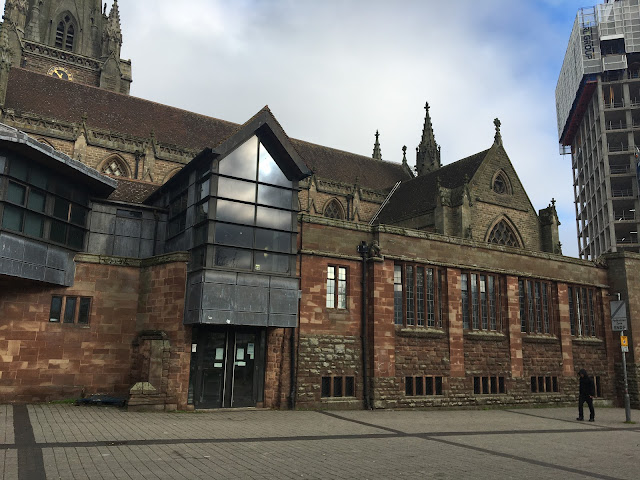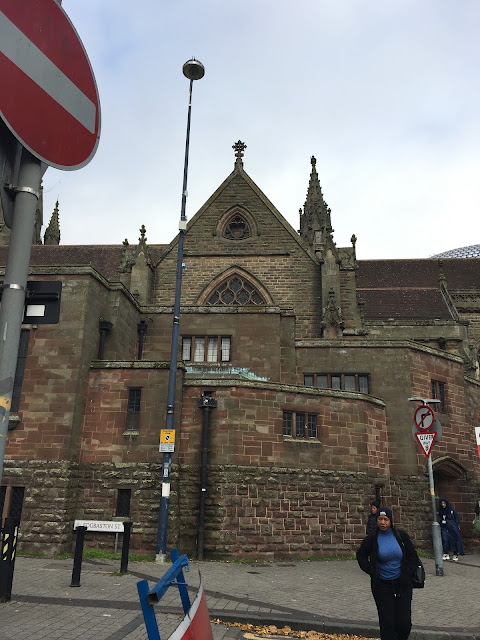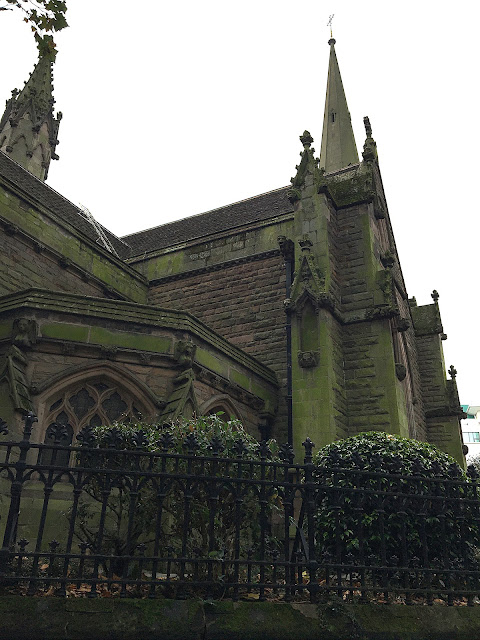In the morning before the concert we had a wander around the city centre - we headed sw from the hotel to St Martin's church in the Bullring, and in doing so we left the new glitzy city of Selfridges and Harvey Nichols and entered another, older city, the other Birmingham.
St Martin's is the mother church of the city. It stands just above the valley floor of the River Rea. Yes, Birmingham has a river. Actually one of several of the blink-and-you-miss-it variety. The spire, for all its blunt hard-faced competition, remains a city landmark.
From most angles the church appears, apart from the tower and spire, low and squat - rather bunker-like from some directions. What the visitor sees today is a nineteenth century rebuild of the original. The only original structure left is the inside of the tower. The rebuilt church is largely the work of the architect J A Chatwin (1830-1907) whose work we have encountered before on this blog. (He was, you may remember, the great grandfather of the novelist & travel writer Bruce Chatwin.) Hammered dressed masonry, and rich Dec period detailing in a rather Lincolnshire manner.* All rather solid and prosperous looking. No expense spared. Slightly contrasting use of Derbyshire and Grinshill stone - the latter from Shrewsbury. Both sandstone, with one used for the walls and the other for the details, my guess is that they chosen in preference over the local, and friable, New Red Sandstone, for their resilience in the smoky atmosphere of the 19th city. Chatwin seemingly had a lot of fun with gargoyles etc. I don't know who designed the ironwork on the great w door but it is splendid. All pomegranates and foliage in the Arts and Crafts tradition. The church was damaged in the war and restored in the mid-fifties.
Sadly the church was locked. I have been in some years ago and all I can recall is that the interior was a lot less solid than the exterior would lead you to believe. On the s side are a series of service buildings - church hall, vestries etc - built over the churchyard;** to the e the earlier stuff in a rather Arts and Crafts manner by the next generation of Chatwin architects, Philip and Anthony Chatwin (1873-1964); and to the w Modernist (prob 1970/80s, but actually 2002-3 by the firm APEC) - a sort of reinterpretation of Ye Olde England. The latter looked as though it were in need some attention if only from a window cleaner. The whole area is somewhat shabby with people sleeping rough around the church. At times I felt I was intruding.
Beyond the church is the market. It was like stepping back into the 1970s. In all a long way from Selfridges.
** There is a tiny strip of churchyard to the north of the church. And although it is a small remnant of the what was once there it is a welcome sight there being so little greenery in that part of the city.











No comments:
Post a Comment